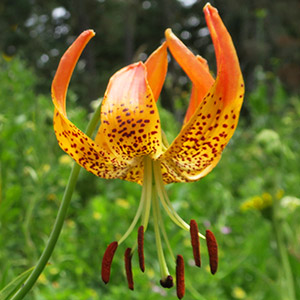Lilium pardalinum
Lilium pardalinum subsp. shastense
California tiger lily, leopard lily, panther lily
Shasta lily
rhizomatous, usually branching, continuously scaly, 1.4–5.1 × 3.9–19 cm, 0.2–0.6 times taller than long;
scales sometimes unsegmented but always some 2–4-segmented on each bulb, longest 1–3.3 cm;
stem roots absent.
branching less often and less regularly than subsp. pardalinum, 2.1–4.4 × 4.4–10.3 cm, 0.4–0.6 times taller than long;
scales (1–)2–4-segmented, longest 1.7–3.3 cm.
to 2.8 m, strongly clonal and thus forming dense colonies, to weakly clonal and forming small colonies or clumps.
to 2.1 m, weakly clonal and not forming large colonies.
rounded in cross section.
usually ± evenly distributed along stem, rarely concentrated proximally, scattered or in 1–6 whorls or partial whorls, 3–19 leaves per whorl, horizontal and drooping at tips to ascending, 4.9–26.5 × 0.3–5.6 cm, 3–34 times longer than wide;
blade usually ± elliptic, wide or narrow, margins usually not undulate, apex acute, often narrowly so;
veins and margins ± smooth abaxially.
± evenly distributed along stem, often scattered in young plants or in 1–4 whorls or partial whorls, 3–13 leaves per whorl, horizontal and drooping at tips or ascending, 5–20.5 × 0.6–3.7 cm, 3–17 times longer than wide;
blade elliptic, sometimes narrowly so, occasionally weakly oblanceolate, margins undulate or not.
1–25(–35)-flowered.
racemose, 1–28(–35)-flowered.
pendent, usually not fragrant;
perianth Turk’s-cap-shaped;
sepals and petals reflexed 1/4–1/3 along length from base, yellow, yellow-orange, or orange proximally, darker orange to red-orange to red on distal 1/5–3/5 (entirely orange or yellow-orange in subsp. wigginsii), with maroon spots concentrated proximally and always surrounded by yellow or orange if extending into distal reddish zone, conspicuously green abaxially on proximal ± 1/5, not distinctly clawed;
sepals not ridged abaxially, 3.5–10.4 × 0.9–2.2 cm;
petals 3.4–10.2 × 0.9–2.5 cm;
stamens moderately to strongly exserted;
filaments moderately to widely spreading, diverging 7°–22° from axis;
anthers ± magenta or sometimes orange, orange-pink, or pale yellow, 0.5–2.2 cm;
pollen red-brown, red-orange, brown-orange, rust, orange, or yellow;
pistil 3.1–7.5 cm;
ovary 1–2.2 cm;
style green, often pale, rarely sordid;
pedicel 6–32 cm.
not fragrant;
sepals and petals reflexed 1/3 along length from base, yellow-orange or orange proximally, darker orange to red-orange to red on distal 1/3–1/2;
sepals 3.7–7.6 × 0.9–2.1 cm;
petals 3.7–7.6 × 0.9–2.2 cm;
stamens moderately exserted;
filaments moderately spreading, diverging 7°–19° from axis;
anthers orange, orange-pink, or ± magenta, 0.5–1.4 cm;
pollen yellow to bright orange, occasionally red-orange;
pistil 3.3–4.4 cm;
ovary 1.2–1.8 cm;
pedicel 6.3–27 cm.
2.2–5.7 × 1.2–2.1 cm, 1.5–3.7 times longer than wide.
2.2–4.3 × 1.2–1.9 cm, 1.6–2.9 times longer than wide.
123–264.
132–177.
= 24.
Lilium pardalinum
Lilium pardalinum subsp. shastense
Subspecies 5 (5 in the flora).
The subspecies of Lilium pardalinum display a classic pattern of discrete geographical ranges with intervening zones of introgression, and no two occur sympatrically without intermixing. Plants in the hybrid zones are confusing in appearance and cannot be assigned to subspecies. However, each subspecies is fairly well marked within its core distribution. With the exception of subsp. pitkinense, the subspecies of L. pardalinum can be common plants in the proper habitats within their rather narrow distributions.
Leaf size and shape are quite variable in Lilium pardalinum subspecies and often clearly dependent on environment. In populations that typically have narrow, ascending leaves, shaded plants often have wide, horizontal leaves. This hampers taxonomic separation as well as identification, especially of herbarium specimens. Further field study is desirable.
Lilium pardalinum is primarily pollinated by western tiger swallowtails (Papilio rutulus Lucas, family Papilionidae) and pale swallowtails (P. eurymedon Lucas); several species of hummingbirds (family Trochilidae) are also important visitors, especially when butterflies are rare.
The Atsugewi, Karok, and Yana ate Lilium pardalinum bulbs steamed or baked in an earth oven (D. E. Moerman 1986).
(Discussion copyrighted by Flora of North America; reprinted with permission.)
Subspecies shastense occurs in the Sierra Nevada from Plumas and Butte counties north to the region surrounding Mount Shasta, west to eastern Trinity County and to western Siskiyou County, where it intergrades with subsp. wigginsii. Plants from near Klamath Falls, Oregon, appear to be this subspecies, though live material from this locality has not been studied. The southern limit of subsp. shastense may extend as far as Placer County at moderately high elevations (ca. 1800 m) in the Sierra Nevada.
(Discussion copyrighted by Flora of North America; reprinted with permission.)
1. Sepals and petals uniformly yellow or yellow-orange; sepals 3.5–7.1 cm; anthers pale yellow, 0.5–1.3 cm; pollen yellow or orange; pistil 3.1–4.3 cm; capsules 2.3–4.2 cm; n California, s Oregon. | subsp. wigginsii |
1. Sepals and petals ± 2-toned, with yellow or orange proximally, distal 1/5–3/5 darker orange to red; sepals 3.7–10.4 cm; anthers magenta, occasionally purple or orange, 0.5–2.2 cm; pollen yellow to rust; pistil 3.3–7.5 cm; capsules 2.2–5.7 cm; California, s Oregon. | → 2 |
2. Sepals (5.9–)6.6–10.4 cm; anthers 1.1–2.2 cm; capsules 2.9–5.7 cm; leaves 3–12 times longer than wide, blade ± elliptic; stems strongly clonal, forming large colonies; California. | subsp. pardalinum |
2. Sepals 3.7–8.3 cm; anthers 0.5–1.8 cm; capsules 2.2–4.8 cm; leaves 3–34 times longer than wide, blade elliptic to linear; stems weakly to moderately clonal, sometimes forming small colonies; n California, s Oregon. | → 3 |
3. Leaves 7.3–34 times longer than wide, often concentrated proximally, often ascending, sometimes horizontal, blade ± linear; sepals (4.9–)5.3–8.3 cm; anthers 0.6–1.8 cm; pollen usually dark orange; extreme nw California, adjacent s Oregon. | subsp. vollmeri |
3. Leaves 3–17 times longer than wide, ± evenly distributed along stem, ± ascending or horizontal, blade ± elliptic; sepals 3.7–7.6 cm; anthers 0.5–1.4 cm; pollen yellow, orange, or red- or brown-orange; n California, s Oregon. | → 4 |
4. Pollen red- or brown-orange; anthers magenta; bulb scales usually 2-segmented; n Coast Ranges near Sebastopol, California. | subsp. pitkinense |
4. Pollen usually yellow or bright orange; anthers orange to magenta; bulb scales (1–)2–4-segmented; ne California, adjacent s Oregon. | subsp. shastense |
